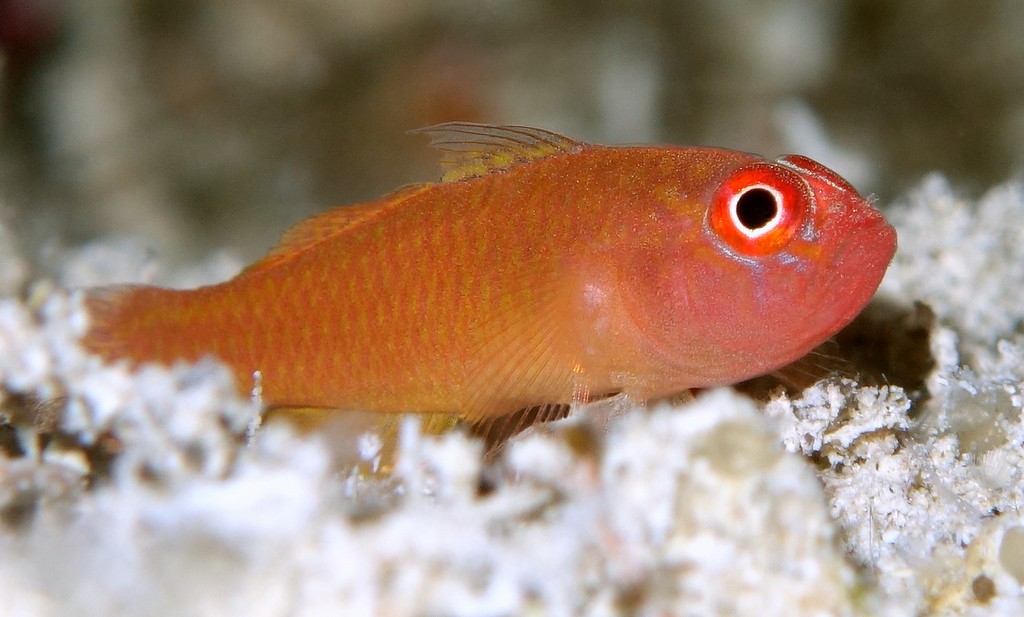TRIMMA BENJAMINI - (WINTERBOTTOM, 1996)
Picture courtesy of: Alain Daoulas
Gobie pygmée à oeil cerclé, Redface dwarf goby, Redface dwarfgoby, Redface goby, Ring-eye pygmy-goby, Ringeye pygmygoby, Ringeye pygmy goby, Megane benihaze, メガネベニハゼ,
Description
Dorsal spines (total): 7; Dorsal soft rays (total): 9-10; Anal spines: 1; Anal soft rays: 8-10; Pectoral fin rays (total): 17-21, branched pectoral rays: 7-11. A species of Trimma with a deep concave, ‘U’-shaped interorbital trench; Bony interorbital about half pupil-diameter in width; A slight groove posterodorsal to the eye; Predorsal midline naked, sides of nape covered with small scales to or near to the eyes; Cheek and operculum naked; Pectoral-fin base with oval, moderatesized scales; Prepelvic area with 5-6 rows of cycloid scales, isthmus naked anteriorly, one slightly enlarged scale on the membrane between the bases of the pelvic fins; Central 6-13 pectoral rays branched, uppermost and lowermost rays unbranched; Fifth pelvic-fin ray branched once dichotomously and about 60-75 % length of the fourth; Other rays usually with one sequential branch, basal membrane connecting the two pelvic fins only at the base; Second dorsal spine longest, usually filamentous, reaching at most to midway along the base of the second dorsal fin in Australian material; Nape crest fleshy from the first dorsal origin to above the operculum; Head and body red in life, yellow in preserved material, head with a thin vertical grey (bluish grey in life) bar from the anteroventral margin of the eye to the middle of the jaws and a second bar extending more-or-less vertically downward onto cheek from about the middle of the eye (often persisting in preserved material as faint grey bars); Orbit rimmed with a thin band of melanophores, more prominent dorsally (faded in preserved material). Max. length: 2.4 cm SL. Max. lifespan: 130 days. Depth range: 4 - 90 m, usually: 4 - 35 m.
Color
Snout and lips red, rest of head and body normally red to reddish orange, rarely yellowish orange; A thin blue bar along posteroventral margin of eye expanding into a thin bar extending ventrally to behind jaws; Anteriorly a thin blue line from anteroventral margin of eye extending to just behind middle of lips; Often with a third blue mark just behind posterior nostril. Pupil surrounded by a thin yellow to gold circle; iris reddish orange, often golden ventrally. Body often with melanophores arranged in vertical wavy lines along centers of scales; Caudal peduncle with faint grey stripes formed by dense subcutaneous dark pigment. Dorsal fins largely clear, with a thin yellow to red stripe just above base of fin; A second thin stripe just below middle of fin, most prominent on second dorsal fin. Second dorsal fin yellowish to pale orange above stripes, with a thin white to bluish distal margin. Anal fin red to reddish orange with thin blue to white distal margin. Caudal fin reddish orange to yellow basally grading posteriorly to a translucent grey, distal margin often pale blue. Pectoral and pelvic fins white to pale grey. Live specimens from type locality (Philippines), and those from Great Barrier Reef overall bright red with underlying dusting of brown chromatophores. Specimens from Palau and some other parts of western Pacific may be much yellower (although adult males exhibit a bright red head).
Variation
Branching of pectoral rays increases significantly with size (p = 0.01, based on 70 specimens selected at random from 15–25.5 mm SL). Specimens below 20 mm SL usually have 5–7 branched rays, while specimens above 20 mm SL usually have 8–11 branched rays. The ranges of counts are, however, highly variable at all sizes.
There is considerable variation in the length of the second filamentous dorsal spine. In most Australian material the spine is typically short, rarely reaching beyond the middle of the second dorsal fin when adpressed. In specimens from the Philippines, the spine often reaches beyond the end of the second dorsal fin.
Pectoral ray counts show significant variation between samples. Samples from Fiji average higher pectoral ray counts (19.0) than other localities. Analysis of Variance on samples of >20 specimens indicate that the samples are not from a single population (p <0.05). Samples from the Great Barrier Reef show little variation, with means between 18.4 and 18.6.
Etymology
Trimma: from Greek, trimma, -atos = something crushed.
benjamini: named for Peter Benjamin of Benjamin Film Laboratory, Toronto who has generously provided free 35 mm color film and processing for my field work over the material examined.
Original description: Trimma benjamini Winterbottom, 1996 - Type locality: Siquijor Island, Tonga Point, 9°12'17"N, 123°27'14"E, Philippines.
Distribution
Indo-West Pacific: Indonesia and Vietnam to Tonga and Samoa, north to Philippines, south to Western Australia, Great Barrier Reef (Queensland, Australia), Lord Howe Island, New Caledonia, Fiji, Solomon Island and Vanuatu.
Biology
Inhabits coastal and outer reef slopes. Benthic, occuring singly or in loose groups, and a plankton-feeder. With prolonged pelagic larval duration of 33.9 days (= 24 % of maximum lifespan) and linear post-larval growth; Daily mortality rate ranging from 2.9 % to 6.3 %; Sex ratio of 1:1.6 male/females.
